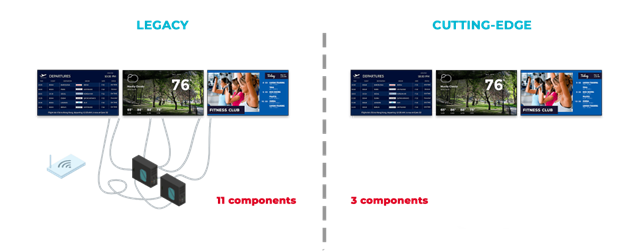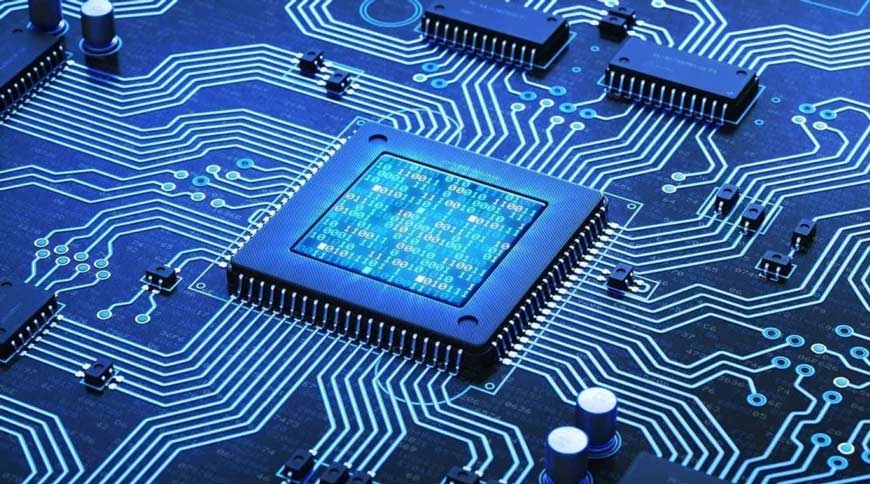System on Chip Compatible Player Software
System-on-chip Compatible Player Software
In digital signage terms, system on chip or SoC, refers to standalone player devices embedded in a digital signage screen. It’s a technology similar to Smart TVs which you find in consumer-grade televisions.
While your typical Smart TV will let you play Netflix, Amazon Video and other proprietary content channels, SoC displays require some type of application to process and screen your digital signage content.
Until the introduction of SoC displays, digital signage used external standalone player devices you mounted behind each screen. SoC displays don’t require an external standalone player or power source. There are no wires hanging from the back of the screen, which makes for a cleaner and more professional installation. System on chip displays are also more secure so there is less risk of someone tampering with the external media player.
The SoC screen market has become very competitive, with some manufacturers going as far as to bundle their own CMS software. Samsung offers MagicInfo and LG markets a solution called Group Manager and each product is designed for their respective SoC displays.
While it’s tempting to use the manufacturer’s own digital signage software CMS, there are many reasons why it’s not necessarily the best choice. Instead consider using a system-on-chip compatible player software produced by a digital signage software company like Navori Labs.
Let’s look at the pros and cons of using a screen manufacturer’s CMS software.
Pros
- Cost less because everything is included in the price of the screen.
- Nothing to install.
Cons
- Not as many features as a professional-grade CMS.
- May not support as many media types as proprietary third-party software.
- No professional template or ticker layout tools included.
- Often tied to specific screen models, or manufacturing dates. No easy upgrade path.
- Unique to each screen manufacturer. You are “locked-in” to a single vendor unless you choose to use different software for each screen brand you manage.
- Many of these products rely on web technologies. While these solutions can be engineered quickly, they don’t perform as well as proprietary software compiled for a specific operating system or hardware platform.
What do professionals recommend?
Digital signage projects usually begin with a standard set of hardware, but as technology advances and business needs change, a variety of devices might be added. It’s a common situation because new products are always emerging and businesses evolve. For instance, a company might install a few display screens now, and then decide to add a touchscreen in the lobby next year. As needs change, it’s important that your software can work with different technologies.
This is why network operators often look for top-notch CMS (Content Management System) solutions that work with various devices. You shouldn’t have to switch your CMS software just because you add a new type of player to your network.
Here’s a typical example: You start by installing some screens in your office from a well-known brand. After a year, you decide to expand your network, but the screen model you initially chose is no longer available. When you switch to a new model from the same brand, you discover it’s not compatible with your current software.
Then, you might consider other types of screens, like touch-enabled tablets or a Windows PC for a large video wall or menu board. But you soon find out that the software from the screen manufacturer isn’t versatile enough. It may only work with a few types of devices or just specific models from its own brand. When the CMS can’t keep up with your new hardware, you’re left having to start over with your setup.

The Navori advantage
Navori is a proprietary, and SSystem-on-chip Compatible Player Software with native versions engineered specifically for each type of device. It is more efficient than other CMS software because it lets users manage different system on chip screen brands and external media players transparently. Navori QL users don’t care which hardware is running at the display. They schedule and publish any content to any player on their network.
Since there is no difference between hardware devices, users can treat every endpoint simply as a “player” knowing their content will be shown reliably and consistently across every display. Only Navori provides full compatibility and shared features across so many devices.
Features like:
- Rule-based content playback.
- Remote content triggering.
- Cross-platform player synchronization.
- Remote device management.
- Dynamic live data support.
- Easy to use template and ticker design tools.
- Content and Player tagging.
- Cross-device content synchronization.
- A complete set of APIs for automating processes.
With some products, users must select which type of media to publish based on the player hardware because sometimes, features on one platform aren’t available on another. Content sometimes needs to be converted or scaled down to match hardware capabilities. This can create problems for users and operators alike.
Navori Player is available in native versions for Samsung Tizen SSSP, LG WebOs and many SoC screen brands that run on the Android operating system, including models from Philips, Sony and ELO touch.
Navori helps reduce your operating expenses (OPEX) because you only need one software to do it all. There is no time lost switching platforms or retraining staff.
Navori Player also supports PCs running on Microsoft Windows and external media players such BrightSign players or Navori’s own Navori Stix 3700. With such a breadth of options, it’s no surprise more network operators prefer Navori over any other digital signage software.

 Copy link
Copy link